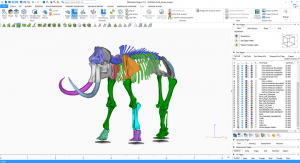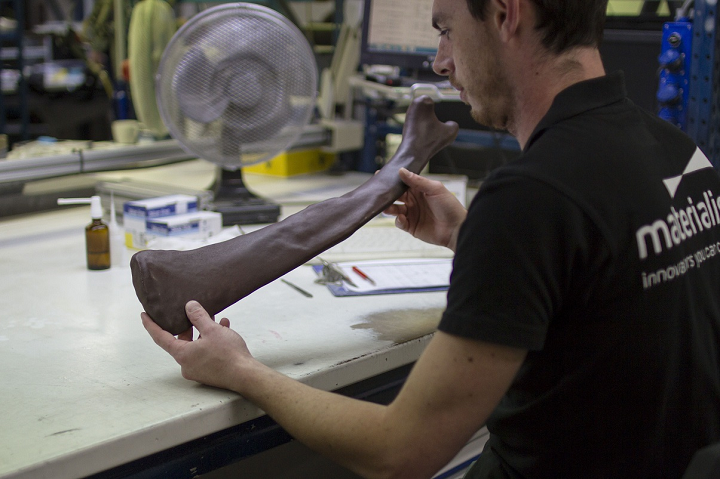 Materialise is in the middle of an SLA 3D printing project of epic proportions…one might even call it a mammoth job. The Belgium-based company is creating a life-size, 3D printed reconstruction of the first mammoth skeleton ever displayed in Western Europe. Fittingly, Materialise is using its extra-large Mammoth 3D printers – the only machines it makes but does not sell – to complete the project.
Materialise is in the middle of an SLA 3D printing project of epic proportions…one might even call it a mammoth job. The Belgium-based company is creating a life-size, 3D printed reconstruction of the first mammoth skeleton ever displayed in Western Europe. Fittingly, Materialise is using its extra-large Mammoth 3D printers – the only machines it makes but does not sell – to complete the project.
The Mammoth of Lier, named for the Belgian city where it was discovered, has been on display at the Royal Belgian Institute of Natural Sciences in Brussels since 1869…nearly 150 years. But now it’s coming home to Lier, where it will be displayed in 3D printed fashion beginning in October.
Materialise is collaborating with the museum to 3D print the entire skeleton, which is made up of 320 bones…the mammoth was, after all, one of the largest land mammals ever to walk the earth. We’ve seen 3D printed mammoth reconstructions and statues before, but not of these proportions. This project was a pretty mammoth task (okay, last one, I swear), but Materialise, with previous experience in 3D printed archaeological projects and historical reconstructions, was more than up to the challenge.
“3D Printing is increasingly proving to be an extremely useful tool in the field of paleontology, allowing us to study fossils without damaging the precious originals, and collaborate virtually on the same fossil with colleagues around the world,” said Dr. Mietje Germonpré, the resident paleontologist of the Royal Belgian Institute of Natural Sciences who worked on the project with Materialise. “Working on the first entire mammoth skeleton ever to be 3D printed has been a unique experience.”
 The company is pooling together all of its interior resources, and calling in some outside help, to make every step of the project – from optimizing scans and building a mount structure outside of the bones to 3D printing the bones themselves – a reality.
The company is pooling together all of its interior resources, and calling in some outside help, to make every step of the project – from optimizing scans and building a mount structure outside of the bones to 3D printing the bones themselves – a reality.
Each bone was scanned on-site at the museum, and together with Dr. Germonpré, Materialise digitally reconstructed the entire thing in order to, as the company put it, “achieve the highest degree of anatomical accuracy.”
Additionally, Materialise Magics software was used to clean up the scans and prepare them to be 3D printed, as scans don’t produce structurally sound 3D forms that are ready for printing.
 Materialise engineers also had a challenge to overcome in developing a more sophisticated, quasi-invisible interior mount structure made of carbon for the skeleton, rather than sticking with the original 19th-century exterior mounting system.
Materialise engineers also had a challenge to overcome in developing a more sophisticated, quasi-invisible interior mount structure made of carbon for the skeleton, rather than sticking with the original 19th-century exterior mounting system.
While working in the digital phase, they had to determine how best to fit this custom structure within the bones, and integrate both entry and exit holes for the carbon tubes. Materialise worked off the automotive tooling expertise of RapidFit, its daughter company, and created a lightweight but sturdy structure that only weighs 300 kg.
“The scale of the project is challenging, particularly because we had to bring different experts together, including engineers, paleontologists and finishing specialists, and align our vision of the finished model, all while meeting tight deadlines,” said Gertjan Brienen, Project Manager at Materialise. “The original skeleton presents some inaccuracies which reflect the knowledge at the time of the original mounting 150 years ago. One example is the length of its tail, which we now know is shorter than initially thought. The original mammoth skeleton is also missing a few bones, including its left tusk. We mirrored the right tusk and recreated it in Materialise 3-matic to achieve a more precise replica than the wooden tusk that was used to complete the original skeleton. The broken upper jaw was also restored accurately by mirroring a part of the original bone structure. This means the 3D-printed mammoth will be more scientifically accurate than the original.”
The replica mammoth bones will soon be 3D printed on nine of Materialise’s Mammoth SLA 3D printers, which the company specifically designed for projects that need an extra-large print capacity. It will take over a month for the mammoth to be 3D printed, as Materialise can only apply 1/10th of a millimetre of resin at a time. Then, it will be finished and painted with a variety of lacquers, paints, and textures to ensure that the bones are a close match to the original skeleton.
Discuss this and other 3D printing topics at 3DPrintBoard.com or share your thoughts in the comments below.
[Images provided by Materialise]Subscribe to Our Email Newsletter
Stay up-to-date on all the latest news from the 3D printing industry and receive information and offers from third party vendors.
Print Services
Upload your 3D Models and get them printed quickly and efficiently.
You May Also Like
3D Printing News Briefs, June 11, 2025: Sustainability, Automotive Tooling, & More
We’re starting with sustainability news in today’s 3D Printing News Briefs, as EOS has strengthened its commitment on climate responsibility, and Zestep is making 3D printing filament out of eyewear...
3D Printing 50 Polymer Stand-In Parts for Tokamaks at the PPPL & Elytt Energy
Of all the world’s things, a tokamak is one of the hardest, most complex, expensive and exacting ones to make. These fusion energy devices make plasma, and use magnets to...
3D Printing News Briefs, May 17, 2025: Color-Changing Materials, Humanoid Robot, & More
We’re covering research innovations in today’s 3D Printing News Briefs! First, Penn Engineering developed 3D printed materials that change color under stress, and UC Berkeley researchers created an open source,...
Firehawk Aerospace Partners with JuggerBot 3D, Gets $1.25M from AFWERX for 3D Printed Propellants
Texas-based Firehawk Aerospace, an advanced energetic materials firm that works with aerospace and defense applications, announced a strategic partnership with JuggerBot 3D, an Ohio-based large-format 3D printer manufacturer. Together, the...



































